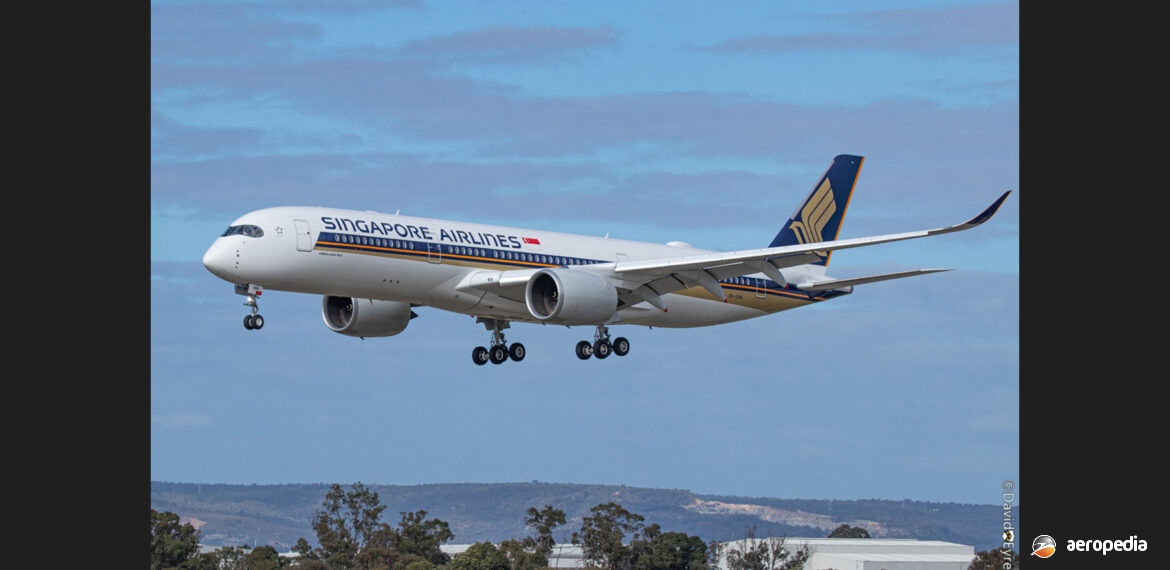Photograph:
Airbus A350-941 9V-SHH of Singapore Airlines at Perth in June 2019 (David Eyre – WA Aviation)
Country of origin:
International
Description:
Long-range commercial airliner
Power Plant:
[A350-900]: Two 83,000 lbst (369.2 kN) Rolls Royce Trent XWB-83 turbofans
Specifications:
- Wingspan: 64 m (210 ft)
- Length: 66.9 m (219 ft 7 in)
- Height: 16.9 m (55 ft 4 in)
- Wing area: 443 m² (4,768 sq ft)
- Cruising speed: 905 km/h (562 mph)
- Range: 15,000 km (9,321 miles)
- Service ceiling: 13,100 m (43,100 ft)
- Max take-off weight: 265,000 kg (584,215 lb)
- Fuel capacity: 138,000 litres (30,356 Imp gals)
- Max payload: 56,382 kg (124,300 lb)
History:
The Airbus A350 series was conceived in 2004 to meet a requirement of international airlines for an extra long-range airliner. It was initially known as the A350-XWB (Extra Wide Body).
The first example completed (c/n 5000) was used for static testing, the first actual flying example, the prototype F-WXWB (c/n 001) commencing ground testing on 31 May 2012, making its first flight at Toulouse on 14 June 2013 flown by Airbus’ chief test pilot. Five aircraft joined the flight test program, delivery of the first aircraft to launch customer Qatar Airways taking place in late 2014.
Three models were initially planned; the A350-800 with a length of 60.6 m (198 ft 9 in) able to carry 276 passengers in a two-class layout for 15,375 km (9,554 miles); the A350-900 with a length of 66.9 m (219 ft 7 in) based on carrying 314 passengers over a range of 15,000 km (9,321 miles); and A350-1000 with a length of 73.9 m (242 ft 6 in) designed to have a typical layout of 369 passengers in a two-class layout and a range of 14,820 km (9,209 miles).
The A350 series was designed to provide airlines with a wide-product line which offered a 25 percent reduction in fuel burn. It is constructed of 70 percent advanced materials, including 53 per cent carbon composites in the fuselage and wings. By late 2014 Airbus had received orders for 749, comprising 35 A350-800s, 539 A350-900s and 169 A350-1000s for 38 customers.
First of the series seen in Australian was an Airbus demonstrator, F-WWYB, an A350-900 (c/n 005) shown to airlines in Australia, New Zealand and the Pacific in August 2014.
First of the type to take up duties in Australasia was A350-941 DQ-FAI (c/n 299 – ex B-LGL [ntu]) of Fiji Airways which first flew on 24 October 2019 and flew its first operational flight from Nadi in Fiji to Sydney, NSW on 23 November 2019. It was initially used on this route, later being joined by a second aircraft on 16 February 2019. Subsequently the aircraft were primarily used on the route between the USA and Australia via Nadi, this route commencing with the A350-900 on 1 December 2019, with flights commencing via Auckland, NZ on 18 December 2019. The second aircraft has been leased from Dubai Aerospace Enterprise Capital, the engines being leased from Rolls Royce. Fiji Airways was the first airlines in the south Pacific to order the A350, ordering two A350-900s by way of lease from Dubai Aerospace Enterprise (DAE) Capital. These aircraft are configured to carry 334 passengers in a two-class layout.
Fiji Airways also has five A330-200s and one A330-300, a further two of the latter being operated for a period on short term leases in 2018. The A330 and A350 share a common type rating, pilots qualified on the A330 being able to fly the A350 by having a difference training course.
By January 2020 orders for the A350 series totalled 35 aircraft for customers. In October 2020 Qantas announced it was replacing a large part of its older aircraft fleet and amongst the aircraft obtained would be a small fleet of Airbus 350-1000s for its non-stop Europe and United States routes. In early May 2021 Qantas announced it had ordered a fleet of twelve A350-1000s for its non-stop services from Australia to Europe and the United States to replace the A330 fleet. In mid 2022 an A350-1000 with Qantas titling visited Australia for demonstrations to airlines.

